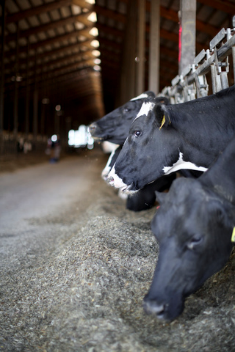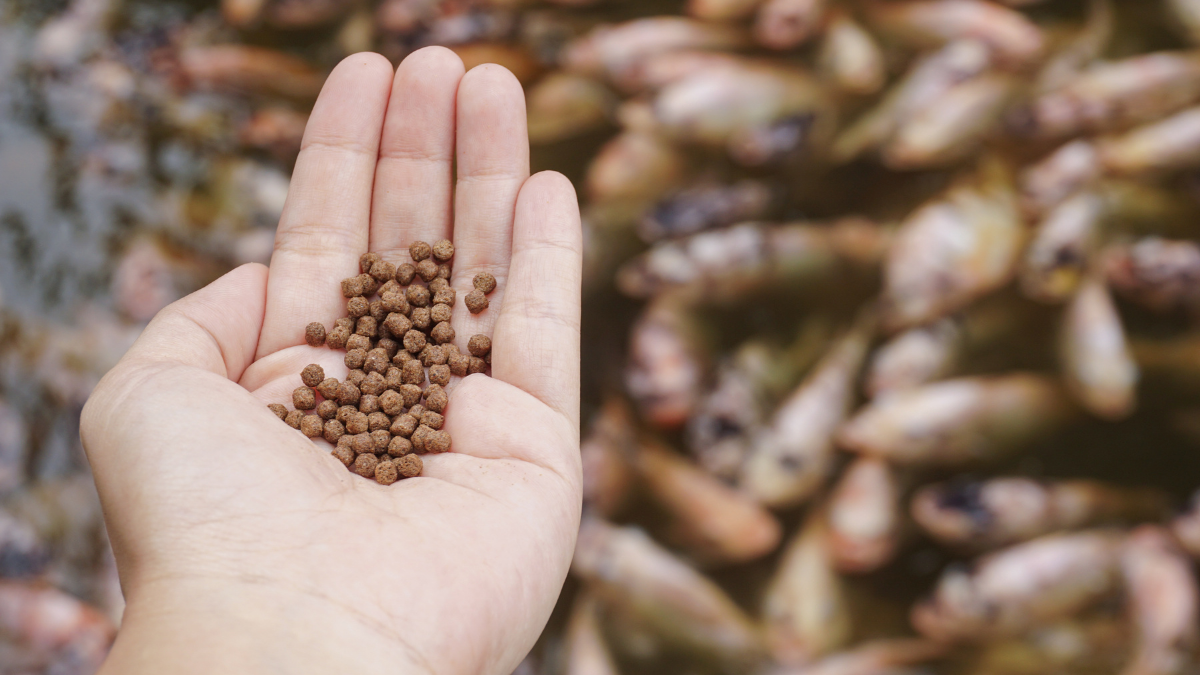En el 2016, la Organización de las Naciones Unidas para la Alimentación y la Agricultura (FAO) señaló que la acuicultura es uno de los sectores productores de proteína animal con mayor crecimiento. Sin embargo, este desarrollo acelerado ha provocado que los nuevos sistemas de producción intensivos tengan que enfrentarse a nuevas enfermedades y a problemas asociados que afectan al cultivo a gran escala. Por lo que ha surgido la necesidad de encontrar modelos productivos alternativos, que permitan abordar estos desafíos y mejoren la supervivencia de los peces; protegiendo, además, la salud humana.
En este contexto, el uso de antibióticos es una de las prácticas que se ha ido prohibiendo en muchos países del mundo, debido a su capacidad de inducir una resistencia cruzada a las bacterias patógenas en las personas. De esta manera, su aplicación y el de los fármacos promotores de crecimiento no está permitido en varios sistemas acuícolas actuales.
Como respuesta a estas prohibiciones y con el fin sustituir los promotores de crecimiento, muchos acuicultores están optando por la inclusión en las dietas de probióticos y prebióticos que son ya ampliamente conocidos en los sistemas de producción tradicionales. También están apostando por el uso de nucleótidos que, por su efecto en la inmunología, pueden tener un impacto positivo sobre la salud intestinal.
Por definición, un nucleótido es una molécula estructurada y diversificada que está compuesta por una base nitrogenada, un monosacárido (pentosa) y uno o más grupos de fosfatos. Nutricionalmente, los nucleótidos no siempre son considerados nutrientes esenciales, ya que pueden ser adquiridos de 2 formas: una ruta de síntesis endógena (a partir de los aminoácidos presentes en el organismo) y por una ruta exógena (a través de la degradación de los aminoácidos y de los nucleótidos que se obtienen a través de la alimentación). Los nucleótidos son considerados condicionalmente esenciales cuando el organismo de los animales necesita una mayor cantidad de estos componentes para enfrentar determinadas situaciones en el ámbito del estrés y de la respuesta inmune (Li y Gatlin, 2006).
De esta forma, una suplementación con nucleótidos a través de la ruta exógena es clave, por ejemplo, para los tejidos y los órganos cuando su síntesis es deficiente –como sucede durante el crecimiento rápido, las enfermedades, la ingesta limitada de nutrientes o el trastorno endógeno–. Además, los nucleótidos juegan un papel importante en casi todos los procesos biológicos: pues actúan como precursores de los ácidos nucleicos (ADN y ARN), proporcionan energía y son reguladores fisiológicos. Diversos estudios han demostrado que la inclusión de los nucleótidos en las raciones puede proporcionar a los animales efectos beneficiosos para el sistema inmune, el crecimiento, el estrés, la salud intestinal y el sistema reproductivo (Li y Gatlin, 2006).
Actualmente, Alltech ofrece NuPro® que es un extracto de levadura rico en nucleótidos, en aminoácidos y en péptidos de alto valor biológico; que ayuda a incrementar la ganancia de peso, a mejorar la salud intestinal (al aumentar la replicación de los enterocitos y las vellosidades intestinales) y representa una fuente de proteína de origen no animal. Esto hace que se optimice el retorno sobre la inversión en los sistemas acuícolas.
En la formulación de las dietas, las fuentes de proteína de origen vegetal son uno de los ingredientes proteicos más utilizados, pero estas fuentes proteicas cada vez están menos disponibles en el mercado y sus costos son más altos; pero pueden ser reemplazadas por NuPro®. La eficacia de NuPro® como fuente de proteína ha sido validada para diversas especies de peces y camarones (incluidas la tilapia, la cobia, el camarón tigre negro y el camarón blanco del Pacífico). En diversos ensayos, realizados para desarrollar alimentos orgánicos certificables para estos animales, se ha demostrado que es posible la sustitución completa de la harina de pescado y de soya por NuPro® (Craig y McLean, 2005).

Le presentamos 5 beneficios comprobados de los nucleótidos para la nutrición acuícola:
-
Apoyan el sistema inmune
Mantener un buen estado inmunológico ayuda al organismo de los animales a protegerse de los patógenos; especialmente de las enfermedades parasitarias, bacterianas y virales que surgen por el deterioro y la contaminación de las piscinas y/o tanques (que se generan cuando se incrementa la densidad de los peces). Una suplementación con NuPro® favorece la respuesta inmune innata a través del aumento de la actividad de la lisozima sérica (una importante molécula de defensa del sistema inmune de los peces). Esta lisozima sérica tiene propiedades antivirales, antibacterianas y antiinflamatorias, y su incremento es considerado como un mecanismo de defensa natural en los peces (Krüger y Werf, 2018). Otros estudios demuestran la capacidad de NuPro® para mejorar la respuesta inmune en los camarones y en especies de peces como el pirarucú: por ejemplo, se mejoró la respuesta inmune innata a través de niveles significativamente más altos de trombocitos, linfocitos, monocitos y neutrófilos; en comparación con el grupo de control (Hoshino et al., 2020; Craig y McLean, 2005). Asimismo, Jarmołowicz et al (2013) observaron que en 8 semanas de suplementación con 40 g de NuPro® por kg (que contiene aproximadamente 0.22% de nucleótidos exógenos) se mejoró la inmunidad innata de la lucioperca al estimularse los mecanismos de defensa celular inespecíficos a través de un aumento de la actividad metabólica de los fagocitos sanguíneos y de los macrófagos propensos, y del incremento de la muerte intracelular.
-
Favorecen el crecimiento
NuPro® ayuda a mejorar la composición muscular por tener nucleótidos y proteínas, lo que propicia un aumento en la calidad de la carne de los peces (Yin et al., 2015). La inclusión de nucleótidos en la dieta de los peces beneficia, además, el rendimiento del crecimiento en las primeras etapas de desarrollo. Esto debido a que la síntesis natural de los nucleótidos puede ser insuficiente para respaldar la replicación celular de forma rápida durante el crecimiento; por lo que la adición de nucleótidos en las raciones puede satisfacer su alto requerimiento. El efecto positivo en el crecimiento de los peces también puede estar relacionado con la calidad del alimento consumido por los animales, ya que los nucleótidos mejoran la conversión alimenticia y la eficiencia en la utilización de las proteínas (Ringø et al., 2011).
Resultados positivos con NuPro® se han encontrado en diferentes especies de peces como el salmón del atlántico, la trucha arcoíris, la tilapia, la carpa y el pez cebra; que lograron un mayor crecimiento. En otros estudios, también se observó el crecimiento de la tilapia, la cobia, el pirarucú y el camarón (Hoshino et al., 2020; Craig y McLean, 2005).
-
Mitigan el estrés en los peces
El estrés es una condición en la cual el equilibrio fisiológico dinámico (u homeostasia) –que está determinado por el organismo– es perturbado por un estímulo intrínseco o extrínseco. En los sistemas acuícolas algunos factores estresantes son: el transporte, la captura, la densidad, la temperatura o el cambio de agua; que pueden tener efectos negativos en el crecimiento, la respuesta inmune o la resistencia a los patógenos.
La inclusión de nucleótidos antes de un período de estrés ayuda a mitigar la influencia de estos factores. Ya que los organismos en condiciones estresantes requieren más energía para hacer frente a un entorno cambiante, por lo que los nucleótidos dietéticos cumplen rápidamente un papel importante en apoyar la respuesta de las células frente a los eventos de estrés. Estos reducen el requerimiento extra de energía para que los peces puedan resistir mejor el estrés causado (Ringø et al., 2011).
-
Benefician la salud intestinal
Una suplementación con nucleótidos apoya la salud intestinal, ya que pueden influir de forma positiva en los procesos fisiológicos, en la morfología y en el microbiota del intestino. Además, pueden incrementar la asimilación y la utilización de otros nutrientes esenciales para la vitelogénesis y el rendimiento reproductivo (Li y Gatlin, 2006).
Se ha demostrado que los peces alimentados con nucleótidos presentan un sistema intestinal más saludable: se ha comprobado entre un 18-21% de aumento de la ramificación lateral y de la altura de los pliegues intestinales. Y una mayor altura de los enterocitos y de las microvellosidades. Esto da como resultado un aumento total de la superficie intestinal, una mayor eficiencia en la digestión y una mejora en la absorción de los nutrientes (Burrells et al., 2001; Xu et al., 2015).
-
Ayudan al sistema reproductivo
La reproducción de los peces y la calidad de los huevos y de las larvas se ven afectadas por la nutrición de los reproductores. Por eso, es importante tener en cuenta que la suplementación con nucleótidos puede ser beneficiosa para el rendimiento reproductivo ya que, por ejemplo, la ovogénesis es un proceso de intensa división celular; que requiere una alta formación de ácido nucleico y una alta cantidad de nucleótidos. En un estudio de peces de agua fría en el que a las dietas de los reproductores se les incluyó nucleótidos dietéticos, se observó que se mejoró la fecundidad, la calidad de los huevos, la calidad de las larvas y la supervivencia de los alevinos (Ringø et al., 2011).
Es clave tener presente estas nociones para que los peces alcancen un desempeño óptimo gracias a los beneficios comprobados de los nucleótidos. Además, es importante conocer los requerimientos para cada especie de peces (en sus diferentes etapas de vida) y determinar así la tasa de inclusión requerida.
Referencias bibliográficas:
- Burrells et al. (2001). Dietary nucleotides: A novel supplement in fish feeds: 1. Effects on resistance to disease in salmonids. Aquaculture 199, 159-169. https://doi.org/10.1016/S0044-8486(01)00577-4
- Craig, S.R. and Mclean, E. (2005).The organic aquaculture movement: A role for NuPro as an alternative protein source. In: Nutritional biotechnology in the feed and food industries: Proceedings of Alltech´s 21st Annual Symposium (T.P. Lyons and K.A. Jacques, eds.). Nottingham University Press, UK, pp. 285-294.
- Hoshino et al. (2020). Innate immune response of pirarucu improved with yeast-supplemented diets. Aquaculture Reports 18:100421. https://doi.org/10.1016/j.aqrep.2020.100421
- Jarmołowicz et al. (2013). Immunomodulatory effect of dietary brewer’s yeast extract in Sander lucioperca juveniles against the challenge of Aeromonas salmonicida. Aquaculture International 21(4), 939-945. 10.1007/s10499-012-9546-0
- Krüger, B.D. and van der Werf, M. (2018). Ohly application note benefits of nucleotide supplementation in aquaculture: Fish 1-4.
- Li, P. and Gatlin, D.M. (2006). Nucleotide nutrition in fish: Current knowledge and future applications. Aquaculture 251, 141-152. https://doi.org/10.1016/j.aquaculture.2005.01.009
- Ringø et al. (2011). Use of immunostimulants and nucleotides in aquaculture: A Review. J. Mar. Sci. Res. Dev. 02, 1-22. https://doi.org/10.4172/2155-9910.1000104
- Xu et al. (2015). Effects of dietary yeast nucleotides on growth, non-specific immunity, intestine growth and intestinal microbiota of juvenile hybrid tilapia Oreochromis niloticus ♀ × Oreochromis aureus ♂. Anim. Nutr. 1, 244-251. https://doi.org/10.1016/j.aninu.2015.08.006
- Yin et al (2015). Effects of yeast nucleotide on growth performance, serum immune index and muscle composition of Ancherythroculter nigrocauda Yih & Wu. Iran. J. Fish. Sci. 14, 646-659.

















